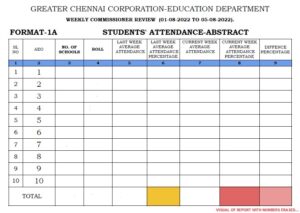Metrics, metrics and more metrics. The challenge for people who work in education worldwide. How does one differentiate between outputs and outcomes? The hardest part of most developmental interventions, especially in education and training, is measuring impact. It is hard to measure inputs and even harder to measure outcomes; so multilaterals for years stuck to measuring outputs. They have now proposed the new concept of learning-poverty, which is the number of children below the age of ten who cannot read simple text.
It is a matter of pride for Chennai that we have a Commissioner of Greater Chennai who just intuitively understands the need to measure outcomes rather than mere outputs in education and has evolved his own set of metrics to monitor both. When you first meet Gagandeep Singh Bedi, you see him sitting with his team poring over a report that includes the things that he monitors weekly. These include the abstract of student attendance, an abstract of a weekly test review, an abstract of teacher attendance, school wise infrastructure details review which includes toilet cleaning data and data on attendance of sanitary workers. Additionally, the Commissioner reviews an abstract of whether homework is done or not, which has likely taken the system by surprise. For these data items to be reviewed at the Commissioner level is amazing, even more surprising is that they are reviewed in minute detail on a weekly basis.
One of the most critical pillars of development is an educated population. Better education contributes to better health, better stability and peace and better gender equity.
Corporation’s two pronged strategy
He elaborates that the Corporation has taken a two pronged strategy to improve education in Corporation schools. He describes this as the hardware and the software of educational intention. By software he means teacher training, proper testing, counselling of parents, the Montessori environment for young children to be extended to more schools, attendance of teachers and staff and strengthening management and institutional capacity, and strengthening government leadership. For example, he has seen to it that HMs participate in classroom observation, several hundred teachers underwent leadership training and several hundred others underwent ICT training.
Focus on Corporation Schools
Most multilateral reports that focus on education would highlight these critical factors in some form or the other. However, where Bedi’s efforts are commendable is that he has unpacked these qualitative terms and defined softer factors into actual measurable data.
Take a look at the sample report below prepared for Students Attendance (Table 1). Like-wise reports on Teacher’s Attendance; weekly test report; homework, school wise infra details report are prepared and analysed on a weekly basis.
Of course, he takes care of what he calls the hardware as well. Ergonomically designed benches, a partnership with the French firm Cassis, work given to the government run TANSI, building toilets, renovating toilets and so on. A French development bank has gotten involved in Corporation Schools.
He oversees all these innovations along with the other schemes launched by the Tamil Nadu Government. These include giving Chennai schools a makeover and reducing learning loss through volunteers who teach children after school.
The Greater Chennai Corporation Commissioner Bedi is a man of detail in all his portfolios. . It was obvious from the last question he asked me. “What do you think of the Corporation?” I said that I deeply appreciated the work in waste management. He smiled and said that he was going to change the song that the waste collection trucks play. Two days ago, the song was changed.

